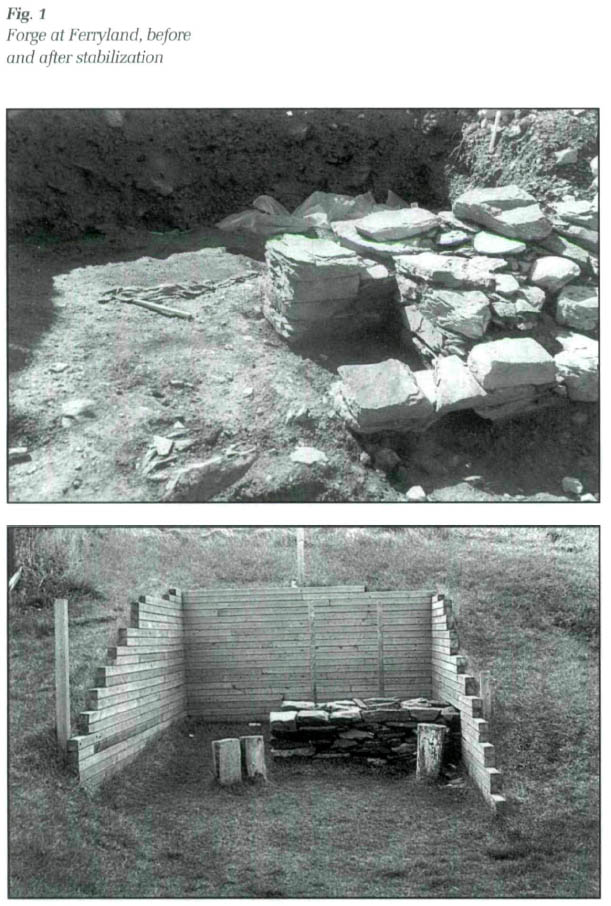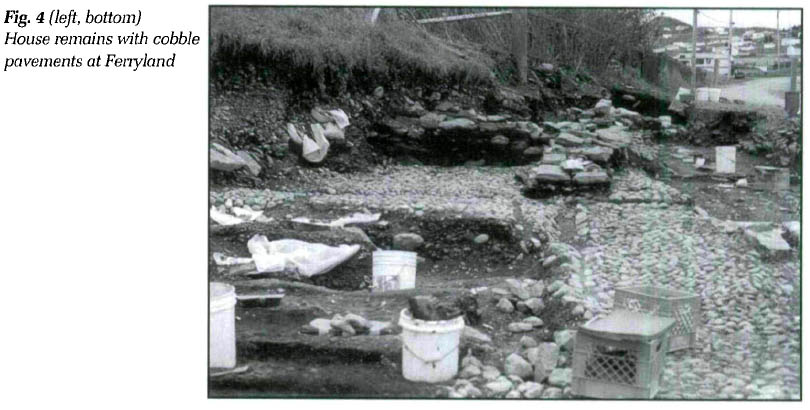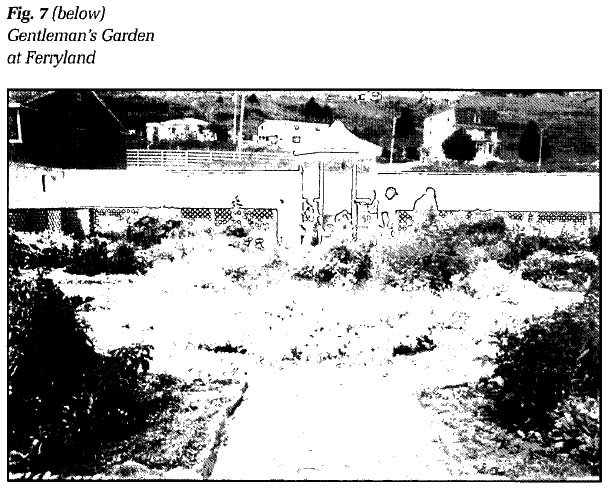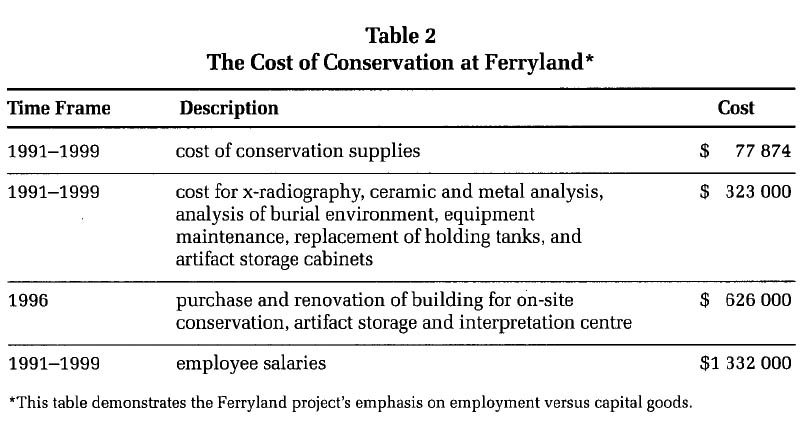Articles
The Impact of Conservation on an Archaeological Site in Ferryland, Newfoundland
Abstract
In North America, archaeological sites have become an important component of cultural tourism. The exposure of our heritage resources has an impact not only on the remains but also on those involved in its interpretation and preservation. This paper explores these issues using a reflexive methodological approach based on my experience as conservator for a large historic site in Ferryland, Newfoundland.
Résumé
En Amérique du Nord, les sites archéologiques sont devenus un élément important du tourisme culturel. L'exposition des ressources du patrimoine a des effets non seulement sur les vestiges, mais aussi sur les personnes engagées dans leur interprétation et leur conservation préventive. Cet article développe ces questions selon une approche méthodologique autoréférentielle basée sur l'expérience vécue par l'auteure en tant que conservatrice d'un vaste site historique à Ferryland, à Terre-Neuve.
1 Changes in culture and society serve as markers of our evolution. Our past is defined in large measure by the tangible objects left behind. Therefore the conservation of these materials, whether a chair or a building, becomes an important part of the current global culture. These acts of conservation and preservation become an expression of a modern peoples' way of maintaining real contact with the cultural works of the past.1 Moreover, through the examination, documentation and interpretation of these materials, we attempt to connect with the people of the past.
2 In this paper I deal with a variety of current issues affecting global conservation and conservators. Today's biggest problem for heritage conservation is the cost of protecting sites because changes in both the physical and political environments threaten their survival. Community involvement and cultural tourism likewise play a role in heritage preservation. This paper will examine my experience as a conservator of culture and will use a personal example and observations drawn from that example. The impact of site preservation to the researcher will also be addressed. This paper reflects upon the intangible aspects of heritage, that is, the effects of the display of cultural material and its conservation on various communities. Current conservation issues such as time- and cost-effective ways to stabilize and conserve large quantities of objects, as well as the use of non-conservators in the field to perform much of the conservation treatments, will be examined. Additionally, this work examines the level of my success in the teaching of conservation methods to community members involved with the project.
3 Over the past ten years I have worked with an archaeological project in Ferryland, Newfoundland. Although our methods for achieving heritage preservation may not be the best, I feel it provides an informative case study. I include here a brief description of my background and how my work relates to cultural heritage. This approach is in part following that established by Bourdieu and followed by Krahn.2
4 A comparative study of another archaeological site, St Mary's City in Maryland, United States, is included as another example of an English colonial site of the same period with material culture remains similar to those at Ferryland. For the Maryland site I have no direct experience, apart from a field trip to the site in February 2001, but rely instead on verbal descriptions and published documents.
5 I will examine how the practice of conservation can change a current culture's perception of the past. This entails the study of individuals who work with the Ferryland project, visitors to the site and my own experiences. When examining the process of knowledge development one must also consider the linguistic, social, political and theoretical elements at play in this process.3 In this way the data-oriented methods become a blend of ethno-methodology and postmodernism with social constructionism serving as a bridge between the two.4 Ethnology, an associated branch of anthropology, involves long periods of immersion in the community under investigation. The ethnologist attempts to assimilate with the culture being studied in order to allow for a better understanding of its subjects. This approach is similar to what I did at Ferryland. For the past ten years I have spent approximately five months of each year working in the community. This reflexive research is therefore combined with participatory research. Together they lead to a clearer understanding of the community's social culture, shared meanings and symbols.
6 For the past sixteen years I have been employed as an archaeological conservator by Memorial University (MU). Prior to this I had worked for three years at the Canadian Conservation Institute and at the Canadian Museum of Civilization. It was with MU that I began my career as an archaeological conservator. As the conservator overseeing a large archaeological excavation I am often required to assist and make recommendations regarding field excavation and site stabilization in addition to supervising the conservation, storage, display and cataloguing of excavated materials. As a conservator I have touched objects produced by peoples of Canada spanning some 9 000 years.
7 If conservation is defined as all actions aimed at the safeguarding of cultural property for the future, then the conservation of heritage affects the current culture in which it is being practiced — the conservation of heritage provides the preservation of objects from a past culture with which, by their presence, the current culture interacts.5 In this way tangible evidence of the past, present and future blends together. The needs and dynamics of a society in turn develop and influence the conservation program. For example, a country's desire to instill a sense of national pride may involve the preservation of an object that symbolizes a history to which the majority of its population can relate. For Canadians this could be a painting by one of the Group of Seven artists. The interest in and means to preserve the past paved the way for the development of the Ferryland archaeology project that I describe below.
8 The seventeenth-century English colonial site at Ferryland, located approximately eighty kilometres south of St John's on the Avalon Peninsula, is the principal focus of this paper. The colony was founded in 1621 by the First Lord Baltimore, George Calvert. The economic base of the colony was the lucrative cod fishery. To date the Ferryland site has produced over 1 000 000 artifacts, stone-built architecture including defensive walls, house structures, roof slates, flag-stone flooring, stone drainage systems and a cesspit or privy complete with vents for effluent removal (Figs. 1 to 4). To date only 12 percent of the original colony described by Captain Wynne in 1622 has been excavated, which should leave one cautious when interpreting certain aspects of the site. From a conservator's point of view the site is a challenge. Much of what has been preserved is inorganic in nature including ceramics, tobacco pipes, brick, glass, iron, lead and copper. In the course often years of excavation, however, wood, leather and textile fragments have also been recovered, although in much smaller quantities.
9 George Calvert visited Ferryland in 1628. Shortly thereafter Calvert requested land further south of Ferryland, and was granted land by Charles I in the Chesapeake Bay area of present-day Maryland. The St Mary's City site was to become home to George Calvert's son Cecil, the Second Lord Baltimore. The site's economic base was the tobacco industry, which brought great prosperity. For the purpose of this paper these two seventeenth century English colonial sites, initiated by the Baltimore family, will be compared with respect to global conservation.
10 Both the Ferryland and Maryland sites cover a period spanning from the 1620s to the 1690s. Artifactual remains are similar as both colonies relied on imported goods from "the old country." In February 2011 visited the St Mary's site and was able to view most of the collection, the interpretation centre, and a living history site, and to interview site staff. The St Mary's City interpretation centre is situated in a refurbished barn complex. The site planners clearly made an effort to incorporate the current archaeological work into the local surroundings. Inside is a state-of-the-art display facility. Exhibit and display cases are simple, and have been built to maintain a stable environment. The material culture depicted is similar to that in the Ferryland interpretation centre.
11 The Ferryland interpretation centre has been installed in a former school. The Colony of Avalon Foundation purchased the abandoned school and renovated the interior and exterior to fit with the architecture of the community. The centre houses an exhibit space, conservation laboratory, collection storage area, office space and two rooms dedicated to community groups. During the winter of 2001-2002 displays within the interpretation centre at Ferryland were updated to incorporate additional information and interpretations drawn from recent and ongoing research.
12 The living history interpretation at St Mary's includes the house of a middling tobacco farmer, with barn, gardens and surrounding fields, a tavern and a seventeenth-century sailing vessel. All of these reproductions [based on archaeological research] provide an interpretive opportunity for the visitor. This was well done and demonstrates the project's concern with and efforts to connect with the general public. Living history interpretation provides an additional representation of the archaeological and historical research to which the public can relate (Figs. 5 and 6).
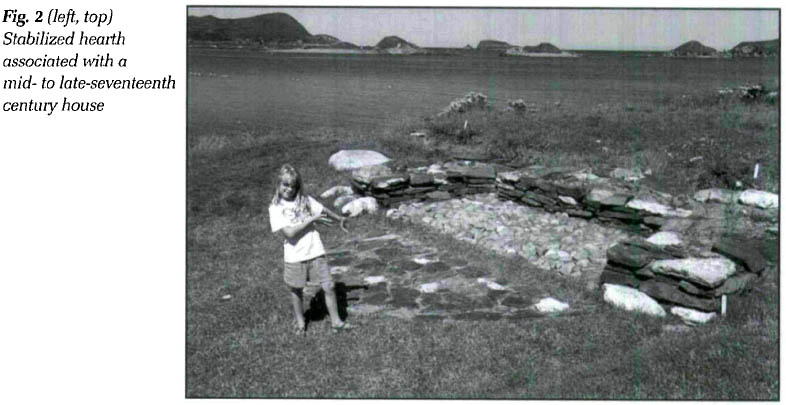 Display large image of Figure 2
Display large image of Figure 2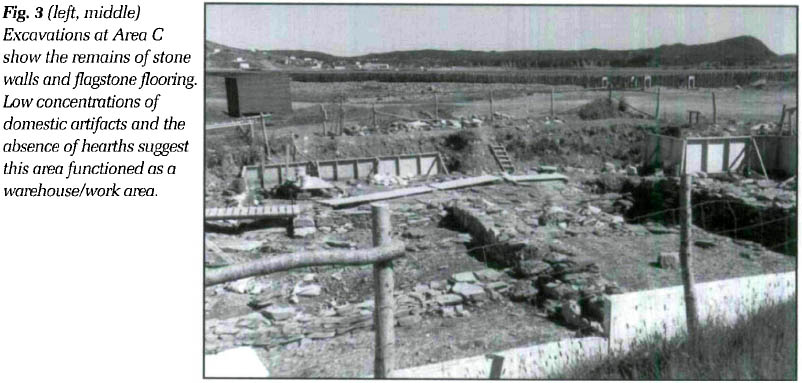 Display large image of Figure 3
Display large image of Figure 3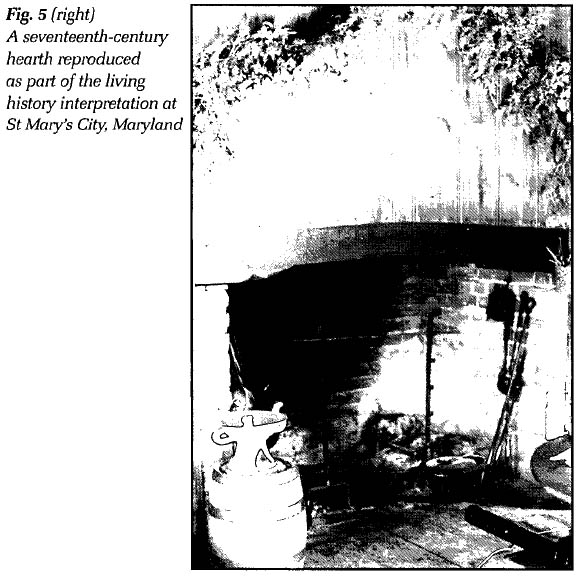 Display large image of Figure 5
Display large image of Figure 5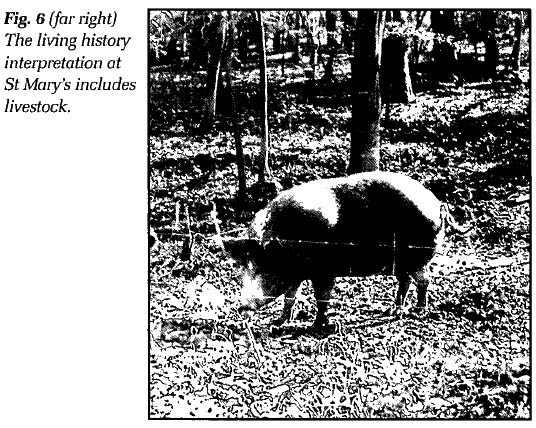 Display large image of Figure 6
Display large image of Figure 613 To date the Ferryland project has developed a seventeenth-century kitchen and two gardens (Figure 7). This is in part because of the high cost of this type of interpretation but also because, after only ten years of excavation (compared with twenty-five years at St Mary's), information on which to base similar interpretation of additional structures is not yet available.
14 For both sites the reproduced structures are not built over any existing cultural resource. These are reproductions based on research garnered from archaeological research at each site. There has been an effort to avoid both rebuilding on the original structures and using any original materials in reconstruction. Conservation activities aimed at safeguarding the original cultural resource in order to preserve its historic value and extend its physical life, still operate. If one reconstructs built heritage then the question of authenticity comes to the fore. Decisions regarding which structure(s) to stabilize, how to stabilize it, what to reproduce and what, if anything, to reconstruct are difficult and must be approached cautiously.6
15 St Mary's College of Maryland at Historic St Mary's City currently offers a summer field school where students have the opportunity to work excavating a section of Smith's Town Land, a three-acre land grant dating to 1666. Students are taught artifact identification while working with the collection. Participants are required to excavate, record information and pack materials for transit to the conservation laboratory.
16 In addition, St Mary's College offers a summer Archaeological Lab School. Here students learn collections management procedures, methods of artifact stabilization, artifact analysis and conservation within a state-of-the-art state-run facility. This course provides students with a grounding in the various processes that follow the actual excavation of artifacts.
17 The archaeological field school component for the Ferryland site has never been promoted in the same way as that at St Mary's. This is in part because MU offers field schools led by MU faculty, in Nova Scotia with Dr Michael Deal and in St John's with Dr Peter Pope. However, I have offered undergraduate, graduate and professional development courses in conservation each year. The well-equipped lab at Ferryland allows students of conservation to perform extensive treatments on a wide range of artifacts. The educational approach is also one which immerses students in the day-to-day operations of a field laboratory. Students are therefore, for part of their experience, paired with staff from the local community. This method of education allows the student to experience and practise both the method and theory of conservation along with being exposed to the local community and the operation of an historic site.
18 Table 1 compares the sites and their infrastructure, staffing and visitation. It should be noted that the Maryland Archaeology Conservation (MAC) Laboratory serves the entire state, fn terms of archaeological remains, those artifacts requiring limited conservation treatment are processed on site at St Mary's city. However, artifacts deemed to have "special historic value" and greater conservation needs are accepted by the MAC lab. Also, while the MAC facility provides state-of-the-art equipment for conservation, there is little money to fund staff positions.7 By contrast the Ferryland laboratory is staffed by fifteen people during the field season. The Ferryland site is also unique within the province of Newfoundland in that it has been deemed the official repository for associated artifacts. Although the conservation laboratories at both MU and Ferryland are adequately equipped, all capital equipment has been obtained from other departments at the university thus allowing funds to be allocated to the hiring of support staff (Table 2).
19 I will briefly discuss the conservation standards for both sites as this indicates the importance of heritage and preservation. The Standards and Guidelines for Archaeological Investigations in Maryland and the Archaeological Investigation Permit Regulations for Newfoundland and Labrador are documents to be followed when investigating an archaeological site. Both documents set standards for archaeological investigation in compliance with provincial/state and federal law for both countries.8 The regulations for Newfoundland and Labrador require the archaeologist to collect all materials found related to the period under investigation and that this material be returned to the official governmental repository fully stabilized and conserved with appropriate accompanying documentation and catalogue. Maryland's regulatory standards are essentially the same as those of Newfoundland. One significant exception, however, is in the quality of materials and methods of packing required for archaeological materials.
20 While in Maryland inert conservation-approved storage materials must be used by archaeologists to pack artifacts, in Newfoundland no such standard exists. Newfoundland's Provincial Archaeology Office has therefore received artifacts packed in everything from paper bags, to beer cases, baby product containers and margarine tubs. A comprehensive document similar to the Standards and Guidelines for Archaeological Investigations in Maryland has yet to be produced in Newfoundland. Therefore some areas of preventative conservation for Newfoundland collections slip through the cracks. Generally, however, both the State of Maryland and the Province of Newfoundland and Labrador recognize their rich archeological resources and have made efforts to protect their cultural heritage. Please note that these standards are not held equally across all provinces or states.
21 Next I will examine the burial environment's impact on the archaeological record. The incomplete archaeological record demands the many techniques and methods of both archaeology and conservation be utilized.9 At the first level is the excavation, which enables the archaeologist to gain maximum information from the buried material. The conservator becomes a key player in this interpretive process as it is her/his job to stabilize and identify past material culture.
22 When examining the impact of conservation on archaeological research one must first consider site conditions for preservation. There is no ideal soil matrix that allows for the preservation of all materials left by past people. Before anything is excavated, therefore, the site has a potential for biased interpretation based solely on soil conditions. Because archaeology is the study of the past, based on what survives, differences in burial environments can significantly impact the research and interpretive processes.10
23 The proximity of the Ferryland site to the Atlantic Ocean (52° N latitude, 47° W longitude) dictates a wet temperate environment in which soils have a high chloride content. The soil is a sandy loam with varying clay concentrations. The soil pH averages about 5.5 but can be as low as 4.5 or as high as 6.0. Inorganic preservation is variable because of the different materials from which artifacts were manufactured (ceramics, glass, iron, lead, copper and stone) and the differential corrosive qualities of the soil. Organic preservation occurs in areas of high moisture content that are relatively anaerobic.11 These pockets of organic preservation include the Pool area, the defensive ditch and the cesspit. Overall this represents a much larger area for potential organic preservation than that found at St Mary's.
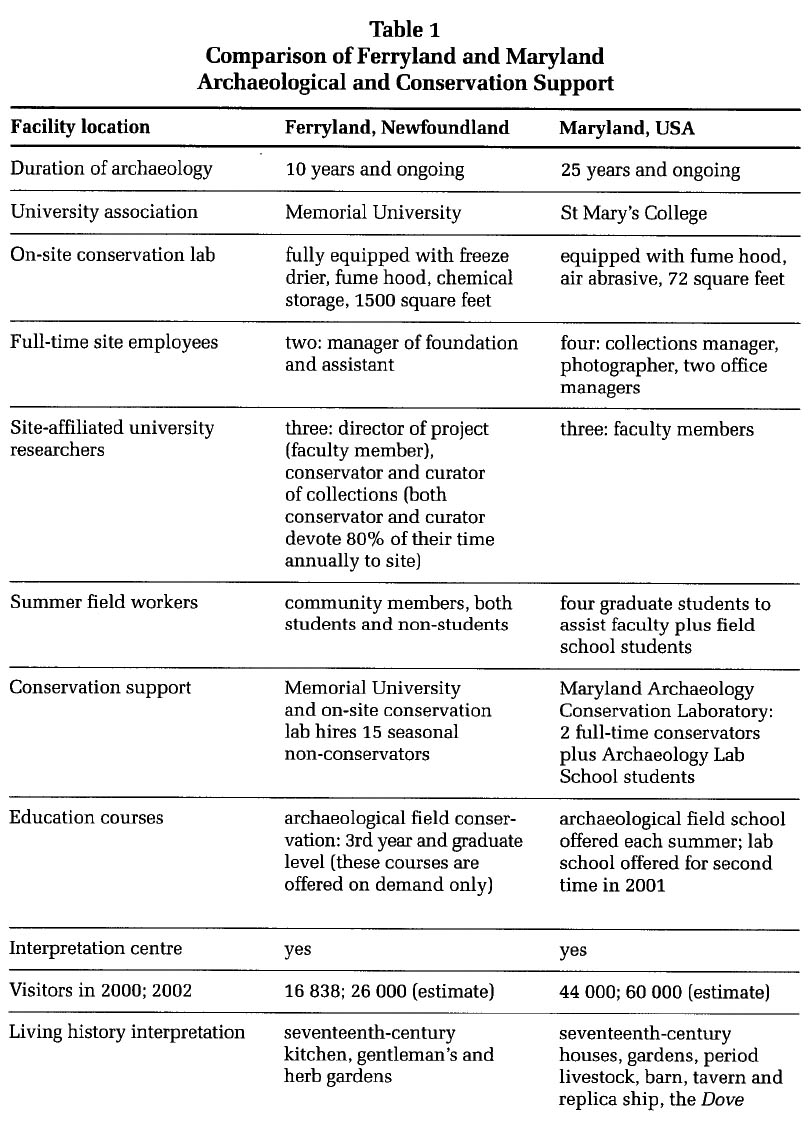 Display large image of Table 1
Display large image of Table 124 St Mary's City, located on the Chesapeake Bay at 35° N latitude, 70° W longitude, has long hot summers, with spring arriving by the end of March and fall weather extending into December. The site is sufficiently inland to be protected from the harsh Atlantic storms with the bay effect providing a moderate climate. The soil appears to be a sandy loam. Based on evidence of artifact preservation observed during my field trip, I suspect the soil pH is close to neutral (with clay acting as a buffer) and that water drainage is good (sandy loam conditions provide pores for water movement). In terms of artifact preservation, this burial environment provides favourable conditions for metals, ceramics, glass, brick and clay pipe fragments but poor conditions for organic preservation. The few textile fragments in the site's collection were removed from lead coffins excavated within the colony's original chapel.
25 Interpretations of the archaeologists, anthropologists, historians or conservators who study either site will be directly affected both by what has survived and how successfully materials were conserved. For example, a researcher of metal buckles would be well advised to study the St Mary's City collection because metal preservation at the site is better and therefore individual objects are mostly complete, providing more information. A conservation scientist or conservator examining the mechanisms of metal deterioration would probably find better examples of corrosion products working with the Ferryland collection.12
26 If one chose to study costume for the period they would be advised therefore to go to the Ferryland collection for both textiles and leather components, and St Mary's for associated buttons and buckles. Another point for consideration is the level of treatment or degree of research on different conservation treatments. For example, although the preservation of metal objects may not be outstanding at Ferryland, much experimentation has gone into the treatment of these metals and therefore what remains has had a 75 percent treatment success rate.13 Though complete preservation is rare at Ferryland, complete stabilization is common and the artifacts numerous. Many more examples could be cited but it is clear the conservation of material culture has a significant influence on the research and, in turn, the interpretation and presentation of a heritage site.
27 Because archaeological excavation involves disturbance of the ground, it will have an immediate environmental impact on the local community. Prior to excavation or development at Ferryland, both the community impact, the conservation needs, and the archaeological impact on the environment were considered. Based on previous experience gained in the excavation of another historic site at Red Bay, Labrador, it was decided that MU would hire a full-time conservator if excavation of this high potential site was to be undertaken. In terms of community impact, negotiations for funding required both an analysis of the environmental impact (which was deemed low — appropriation of land by the Provincial Government in the late 1990s, however, proved unpopular with some community members) and local economic development. It was determined that community residents be given preference in the hiring of staff. Following the failure of the North Atlantic cod fishery and the ensuing moratorium, the Atlantic Canada Opportunities Agency (ACOA) granted funding for archaeological research because it was seen as a significant boost to the local community.
28 In Newfoundland this type of extensive community impact analysis, relative to archaeological work, had rarely been considered. The planning concept report for the archaeological project at L'Anse aux Meadows National Historic Park, for example, makes only two brief references to community impact. One statement notes that the Park will not provide services in conflict with those already provided in the surrounding community, while the second merely describes the recent history of the area.14
29 For the Ferryland project's conservator the experience of working with community members, who formed the work force, became one that involved significant education on the part of both parties. Community members who became the laboratory staff had no background in artifact conservation or archaeological research. I, as conservator, had previous experience (in the Red Bay, Labrador community) working with communities outside of my academic and social cultures. However, as I reflect, this experience did not fully prepare me for the Ferryland context. The end result was that as they learned about artifact conservation I also learned about the dynamics of a rural Newfoundland community. My initial challenge was to prepare an adult education curriculum in a way that created not only a productive working environment but also an enjoyable learning/teaching situation. By providing work and an environment for learning the project was, in our view, improving the social conditions of the community.
30 I would like to note, here, that the term nonconservator has always made me uncomfortable because it implies that we as conservators somehow stand above others. During my career as a field conservator I have spent some 3 000 days in the field stabilizing, conserving, packing, interpreting and sometimes restoring both organic and inorganic artifacts. This could not have been accomplished without the assistance of non-conservators. Most often hired from the local community, these people have learned to identify materials, support, wrap, draw, consolidate, adhere, freeze-dry, air-dry, restore, display and store objects that represent significant moments in history. For the rest of this paper, therefore, I refer to my assistants not as non-conservators but instead as conservation assistants.
31 Overall, I believe that both conservation assistants and conservators have performed the best conservation care for the objects at this time. Though there are now numerous treatment records and stable artifacts that have been studied, both quantitatively and qualitatively, I have never considered the impact of conservation on the people themselves. What follows serves as a reflexive exercise that assesses the impact the conservation process has had on the conservation assistants.
32 The first step as part of this exercise is to identify the gender of conservation. Generally the conservation profession has been, and still is, dominated by women. The profession of conservation has a feminine gender, but as will be demonstrated using the Ferryland case, I feel this is based instead on the division of physical spaces in which this work takes place and not necessarily the sex of the worker. Interestingly, those excavating the site (the archaeologists and field crew) are predominantly male. There is a clear division of labour and space with males doing outdoor physically-demanding work and females performing indoor tasks that require patience and a high level of manual dexterity.
33 The "traditional" division of labour found at the site dictates that the sex of most of the conservation-related jobs be female, creating a hegemonic relationship between conservation and archaeology where the latter dominates. Because community ideology has determined that the conservation laboratory is akin to kitchen space it has become a woman's place while the areas of excavation have become a male space. Both men and women working in the field have, because of this predetermined bias, deemed their work to be of greater importance. The field crew has supported and promoted this sense of dominance over the conservation crew because this reinforces their own cultural perceptions. This perception is reinforced by both visitors to the site and the media. Both groups most often visit the laboratory only if they can fit it into their schedules—the lab comes last. For the visitor this is, in part, a result of the laboratory's location on the second floor of the Interpretation Centre, which is not as readily accessible as either the main floor or the site itself. Film crews prefer the natural light of the outdoors and therefore promote the notion that the excavations are more important because they are depicted more prominently. Shooting indoors is more difficult because of fluorescent lighting and is more time-consuming, therefore the conservation activities are not shown as frequently.
34 A division also exists within the group of conservation assistants. This, I feel, is in part based on the nature of conservation work. Because the profession requires a great deal of documentation and general processing of artifacts, in addition to highly specialized labour, it sets up a division between those that document and those that merely process. During ten years of work with these women I have recognized a high level of skill in some and have tried to foster this ability by having these individuals help with artifact conservation.
35 In order to understand the lab dynamics one requires some background knowledge of the social and cultural environment at the community level. The largest wave of immigration and settlement in this area of Newfoundland occurred during the nineteenth century. A large population of Irish immigrants settled here and most were employed in the cod fishery (both men and women). Under the control of the English merchants, fish was sold to pay debt incurred by the fishermen at the local store (owned by the merchant). In this way the fishermen were always under the control of the merchant. Based on accounts by senior members of the Ferryland community, it is my understanding that the class hierarchy functioned with the Irish fisherman at the bottom and the English merchants at the top. Within this system all fisherman were equal. Not unlike the English class system of the original European colony of the seventeenth century, Ferryland in the nineteenth century was a place where you knew your station and you stayed there for life. To this day this ideology remains strong within the community.15 Having certain people from the community perform some of the specialized work of a conservator was therefore perceived by many as working above one's station. In this instance, there was resistance to working above what was perceived as one's position and most of those still working in the lab have chosen to stick with tasks they were originally trained to perform — not wanting to be different from their fellow employees. Of the fifteen people working in the conservation lab, only five have accepted other duties beyond the normal processing of artifacts.
36 Recognizing that such attitudes exist in the Ferryland community, it is worth examining how those who have shown an interest in advancing their knowledge of conservation differ from those reluctant to do so. Within this group, two members (Parlene and Jean) have been Board Members for the Colony of Avalon Foundation, one person (Debbie) works closely with me in performing various conservation and documentation tasks, one person (Mercedes) oversees the collection storage area and the last member (Marilyn) is responsible for the organization of the ceramic catalogue. Only Debbie and Marilyn have completed some form of post-secondary education.
37 Debbie has a permanent part-time job which runs from February to June each year, is single, has no children and is a recognized Newfoundland artist. Within the community, Debbie has always been viewed as different, in part because she has not married and has no children, but also because one of her parents was not originally from Ferryland. Therefore Debbie felt comfortable accepting a position different from the others because she had always been viewed as an "other" by the community. The four others are married with children. Both Darlene and Jean are more outspoken and both had worked in full-time positions prior to the excavations at Ferryland.
38 Table 3 summarizes what I consider to be the impact conservation has had on support staff with regard to an increase in knowledge or skills in relation to heritage and its preservation. I have based my observations on my experience in evaluation as an educator in conservation method and theory over the past ten years. The information summarized in Table 3 suggests that because of the division of labour between males and females, both groups learn different skills. For example the lab crew's (women) documentation skills, computer skills and knowledge of chemistry have increased as a result of conservation. The lab crew has also learned how to better care for their own heritage objects be they artifacts from the local museum or church, or items in their own homes. The field crew has gained an appreciation for conservation because the objects they have excavated tend to look better after conservation. More important is the fact that I feel most, if not all, of the lab and field crew have, through our conservation and archaeology instruction, become better masters of their own processes of learning.16
39 One significant impact that the conservation of objects has had on the community is through providing an income for conservation assistants. Many of the women working in the conservation lab, as well as the male field crew, depend on this income to help support their families. In this way global conservation and archaeology have had a direct impact on the economic stability of the community.
40 Another impact of archaeology and conservation at the Ferryland site has been the founding of the Colony of Avalon Foundation. This body oversees the allocation of funds, the operation of the gift shop as well as daily service operations associated with the site. Board members have also been members of both the laboratory staff and field crew. This involvement in a high-profile and successful project has brought a sense of pride, self-esteem and empowerment to these individuals. Social change is a complex, disordered and unstructured process. Empowerment becomes a suitable process with which to facilitate social change and create greater equality. By empowering an individual or community you provide them with the necessary skills and confidence to fight the inequalities of the world.17 The involvement of community members in the Colony of Avalon project and administration over the past ten years has provided an environment for the process of empowerment to evolve.
41 The conservation component at Ferryland has also had an impact on tourists. Total numbers of visitors to the St Mary's city site is greater than that of Ferryland (approximately double), however, when considering the population of each country (the USA at some 300 million versus Canada at approximately 31 million), different funding sources, and the length of site operation (ten years for Ferryland versus twenty-five for St Mary's) one realizes the significance of tourism to this Canadian site. At Ferryland, international, national and provincial visitors come to view the archaeological ruins. However, when they arrive at the site their first reaction is to the surrounding physical environment. The site sits at the edge of a spit of land that juts into the North Atlantic. One can experience the imposing force of this ocean, its beauty and, depending on the time of year, its fauna (a variety of birds, whales, fish and icebergs pass through the area each season). The visitor's next impression is of the historical significance of the site itself.
42 Visitors to the conservation lab are able to view the ongoing conservation and processing of artifacts as well as engage in conversation with the staff. People are generally impressed with the organization, the number of people working, their level of expertise and knowledge as well as their friendliness. For whatever reason those doing documentation or conservation of artifacts traditionally end up presenting their own interpretation to visitors. There is no script here, unlike those working as guides in the interpretation centre. This immediate exposure to recent finds as they come into the lab for processing and conservation provides an opportunity for the lab's staff to give visitors an account of the daily activities and finds. Often this type of information tends to be of greater interest than the descriptions of the treatments and chemicals used by conservators. In this way the visitor's experience becomes personalized and therefore part of the collective memory of their visit.18 Because the lab crew do not have a specific mission to educate and promote the historically significant aspects of Ferryland, they can go beyond the "art of interpretation" and offer their own personal interpretation of their relationship to the seventeenth century culture of Ferryland.19
43 To conclude, all heritage sites have a message for those that come to visit (either in person or via the internet, television or video documentation). This message will include something about the history of the site depicted, the infrastructure used in the interpretation of the site and the groups involved with its heritage preservation. In some cases the local community will be included in the description and interpretation of the site. In this way the visitor is also exposed to the cross-cultural aspects of the site as the past culture is being conserved, interpreted and exhibited by the current culture(s) of the same geographic region. Although this latter point might be taken as a given, the excavation and conservation of world heritage sites in Third World countries has often been performed by foreigners from First World countries. Even within Canada, heritage sites located in remote areas (i.e., Newfoundland's Gros Morne and Port aux Choix National Parks, and Labrador's Red Bay National Park) have come under the control of Ottawa-based National Heritage organizations. This is, in part, because local groups could neither finance nor provide the expertise necessary for extensive preservation and development projects. However, by excluding the local community any sense of the current culture is potentially lost. Possibly the most positive result of heritage conservation within a community, I feel, is the inclusion of community members in the act of conservation. Community members learn more about their own heritage, develop important working skills, and gain a sense of self-respect and confidence in part because site visitors are impressed by the overall interpretation in which community members play a key role. Keeping the link between past and present peoples was one of the main factors considered during the planning of the Ferryland project.
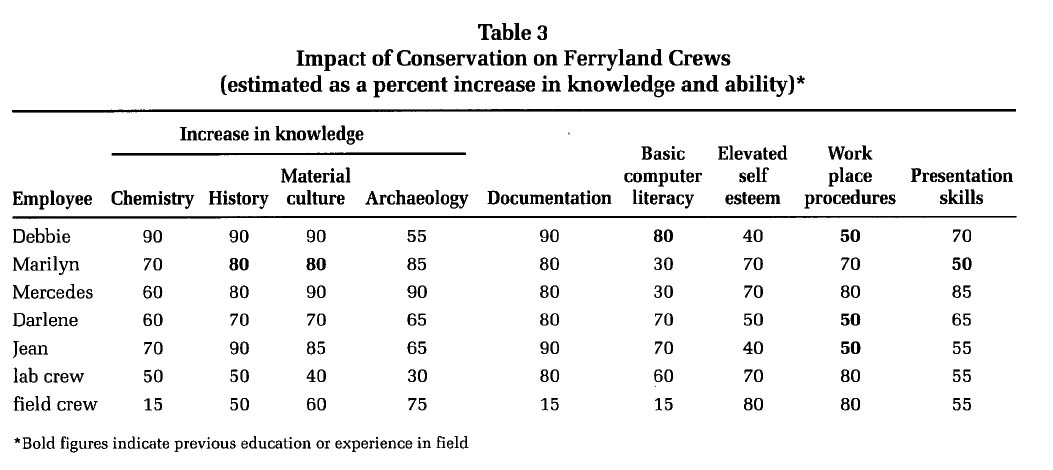 Display large image of Table 3
Display large image of Table 344 From my own perspective I have recognized the ingenuity of past cultures with respect to materials and technology. I have also seen the same ingenuity at work within present-day Ferryland culture. The more I read and understand about globalization the more aware I am of the parallels in human responses to both the seventeenth-century and the twenty-first-century globalization of Ferryland. From an economic perspective, as we become more global we must also become more local. While sustaining the global economy, one must not forget community initiatives as these target specific issues of poverty, human rights and the environment.20
45 This social grounding also includes our need to reach out to past traditions.21 The colonists of the seventeenth century used traditional building construction technology, imported material goods and probably maintained other traditions of the "old country," which the archaeological record preserves.22 The globalized culture of the twenty-first century also attempts to ground itself by connecting with the past. In this sense heritage sites, like Ferryland, become popular with the public.23 The general public tends to view the past in terms of the present with legends, memories and heroes from the past moving forward into the present and vice versa.24
46 When considering a global world one must recognize that it is based largely on commerce. This is as true today as in the seventeenth century. If the cod fishery had not been so rich there would have been little reason to establish a colony at Ferryland almost 400 years ago. Though both periods represent globalization this process is also relatively exclusive in terms of class and ethnicity. It has always been a select few who participate in global commerce. Someone from a Third World country would not be a participant unless brought over as part of the slave trade. This forced migration of people provided the labour base for the growth of a North American capitalist society.25
47 I have learned great patience through my work as a conservator. In a quest to solve problems facing other archaeological conservators in their attempts to stabilize objects I have ventured into other disciplines including earth science, engineering, art history, history and social history. In many ways the impact conservation has had on me is far reaching. With respect to my work at Ferryland probably one of the most important things I have learned is that culture and its associated components are neither perceived nor appreciated the same way by any two people. One cannot, therefore, impose one's own appreciation on others. For example, the five women of the Ferryland lab crew would probably respond in the same enthusiastic manner regardless of who was in charge, likewise those who are there merely for a pay cheque will always be there. Heritage appreciation is something which must come from within. To some extent it may well be a learned response, but to be lasting it must be genuine. When conservation is considered in its entirety — from bench conservation, to education of community, students and visitors, to site stabilization — I think the work at Ferryland should be seen as having a continuing impact and having contributed to approaches of global conservation, heritage development and community development. Finally, I close with a quote from John Ruskin that for me sums up our collective perspective on the objects we create and conserve for the future.
This paper was the result of course work undertaken as a Ph.D. candidate, Queen's University, under the direction of Dr Ann Howatt Krahn. Additionally, I would like to thank the staff and friends of the Ferryland Archaeological Project.
